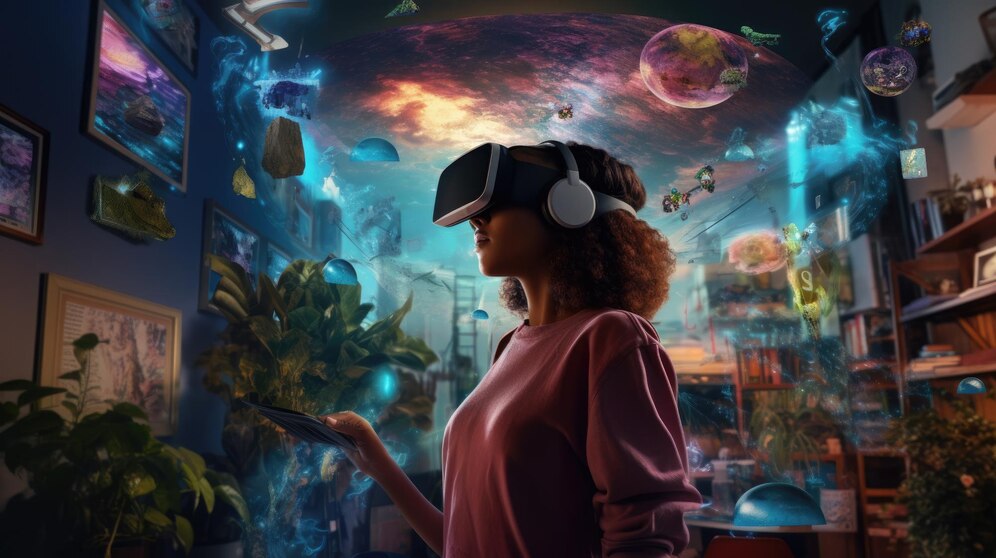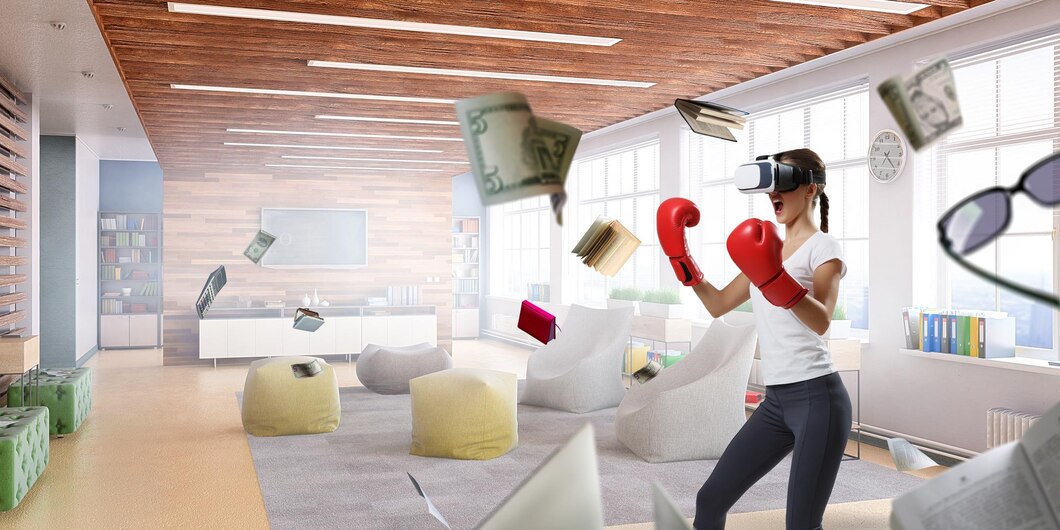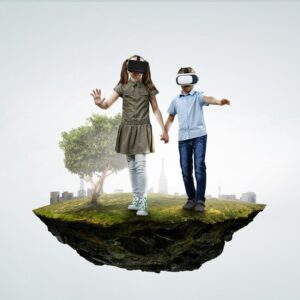In today’s rapidly evolving technological landscape, mixed reality has emerged as a captivating and transformative concept. Blurring the lines between the physical and digital worlds, mixed reality offers a spectrum of immersive experiences that go beyond traditional virtual and augmented reality.
Let’s embark on a journey to explore the fascinating realm of mixed reality, from its definition to real-world applications.

What is Mixed Reality?
At its core, mixed reality combines elements of both virtual and augmented reality. Unlike virtual reality, which immerses users entirely in a digital environment, and augmented reality, which overlays digital elements onto the real world, mixed reality seamlessly integrates digital content into our physical surroundings. This dynamic spectrum of experiences ranges from fully immersive virtual environments to interactive augmented reality overlays.
What is the Need for Mixed Reality?
The need for mixed reality stems from its ability to bridge the gap between the physical and digital worlds, offering a unique and immersive experience. In today’s fast-paced technological landscape, here are a few reasons why mixed reality is gaining importance:
Enhanced User Interaction
Mixed reality provides users with a more engaging and interactive experience compared to traditional technologies. It allows users to actively participate in virtual environments, fostering a deeper connection with digital content.
Real-world Applications
Industries such as healthcare, education, and manufacturing benefit significantly from mixed reality. It enables medical professionals to practice surgeries in virtual environments, students to engage in interactive learning experiences, and engineers to collaborate on virtual prototypes.
Innovation and Creativity
Mixed reality opens new avenues for innovation and creativity. It allows developers and content creators to design experiences that seamlessly blend the real and virtual worlds, leading to the creation of novel applications and solutions.
Improved Training Simulations
The technology proves invaluable in training scenarios, offering realistic simulations for various professions. From medical procedures to complex machinery operations, mixed reality allows individuals to practice and refine their skills in a safe virtual environment.
Collaborative Work Environments
In a world where remote work is increasingly prevalent, mixed reality facilitates collaborative work environments. Colleagues can interact and collaborate in shared virtual spaces, overcoming geographical distances and enhancing teamwork.
Entertainment and Gaming
Mixed reality transforms the gaming and entertainment landscape by providing more immersive experiences. Gamers can become part of the game environment, and entertainment content can be experienced in ways previously unimaginable.
Future Technological Advancements
Embracing mixed reality is a forward-looking approach. As technology continues to evolve, mixed reality is likely to play a pivotal role in shaping the future of human-computer interactions, offering even more sophisticated and seamless experiences.
What are the Applications of Mixed Reality?
Mixed Reality (MR) holds a diverse range of applications that blend seamlessly with our daily lives, enhancing various fields and experiences. Here’s a breakdown of some practical applications:
Mixed Reality in Education
MR offers immersive learning experiences, allowing students to explore historical events, dissect virtual organisms, and engage in interactive simulations. It brings abstract concepts to life, making education more engaging and memorable.
Mixed Reality in Healthcare
In the healthcare sector, MR facilitates advanced medical training through realistic simulations. Surgeons can practice procedures in a virtual environment, enhancing their skills and reducing the risk during actual surgeries. It also aids in patient education, visualizing complex medical conditions.
Mixed Reality in Gaming and Entertainment
MR transforms gaming by integrating digital elements into the real world. From interactive storytelling to physically engaging gameplay, it provides a more immersive gaming experience. In entertainment, MR opens new dimensions for storytelling and content consumption.
Mixed Reality in Business and Collaboration
Businesses leverage MR for virtual meetings, collaborative projects, and training sessions. Team members can interact with 3D models, review designs, and collaborate in real-time, irrespective of geographical distances. This enhances productivity and fosters innovation.
Mixed Reality in Architecture and Design
Architects and designers use MR to visualize and manipulate 3D models in real-world settings. This allows for better decision-making in the design process, helping professionals and clients to understand spatial relationships and aesthetic choices.
Mixed Reality in Tourism and Exploration
MR enhances the tourism experience by providing virtual tours and interactive guides. Users can explore historical sites, museums, or natural wonders from the comfort of their homes. It also aids in remote exploration, such as sending MR-equipped devices to explore hazardous environments.
Mixed Reality in Manufacturing and Maintenance
In manufacturing, MR assists in assembly line processes, offering step-by-step visual guidance. For maintenance purposes, technicians can use MR to overlay information onto physical equipment, facilitating repairs and reducing downtime.
Mixed Reality in Retail and Shopping
MR enhances the retail experience by allowing customers to virtually try on clothing or visualize furniture in their homes before making a purchase. It blends the online and offline shopping experiences, providing a more personalized approach.
Mixed Reality in Sports Training
Athletes use MR for training simulations, analyzing their performance in real-world scenarios. It helps in refining techniques, strategizing plays, and improving overall athletic skills.
Mixed Reality in Social Interaction
MR creates opportunities for socializing in virtual spaces. People can connect, communicate, and collaborate in shared environments, transcending physical boundaries.

Key Features of Mixed Reality
What sets mixed reality apart are its key features—user interactivity and immersion. Users don’t just observe; they actively participate in the digital landscape.
This level of engagement creates a more profound and memorable experience.
Examples of Mixed Reality
To better comprehend the concept, let’s explore some concrete examples:
Architects visualizing building designs in 3D space, engineers collaborating on virtual prototypes, or artists sculpting digital creations in the air—all of these represent the tangible outcomes of mixed reality at work.
Future of Mixed Reality Technology
As technology continues to advance, the future of mixed reality holds exciting prospects. From enhanced medical training simulations to collaborative virtual workspaces, the potential applications are limitless. The evolution of mixed reality is a journey worth following as it reshapes how we interact with the digital realm.
Conclusion
In conclusion, mixed reality stands at the intersection of the physical and digital worlds, offering a tapestry of experiences that captivate and transform. As we navigate this dynamic landscape, the key is to embrace the possibilities and innovations that mixed reality brings. Whether for work, play, or education, mixed reality is redefining how we engage with technology.
Thank you for enjoying the content on this blog. Feel free to visit the great info website regularly to stay updated on the latest technology trends. Wishing you a wonderful day!
More Important Mixed Reality Key Terms to Discuss
Mixed Reality Portal and Glasses
To delve into mixed reality, one must acquaint themselves with the mixed reality portal, a gateway to a myriad of immersive experiences. Paired with specialized glasses, these portals transport users to a world where the boundaries between reality and digital content fade away. Various companies have ventured into creating mixed reality glasses, each offering unique features and applications.
Windows Mixed Reality
Microsoft, a pioneer in the tech industry, has a significant footprint in the mixed reality domain with its Windows Mixed Reality platform. Offering a range of features and functionalities, Windows Mixed Reality caters to both casual users and developers, fostering a rich ecosystem of mixed reality content.
Mixed Reality Games
Gaming enthusiasts have witnessed a paradigm shift with the integration of mixed reality. From interactive storytelling to physically engaging gameplay, mixed reality games provide a level of immersion that traditional gaming experiences often lack. Dive into a world where the boundaries between the game and reality blur.
Meta Quest Mixed Reality
Meta, previously known as Facebook, has ventured into the mixed reality space with its Meta Quest platform. This initiative aims to make mixed reality accessible to a broader audience, offering a range of products that seamlessly blend the physical and digital realms.
Mixed Reality Headsets
Choosing the right mixed reality headset can significantly impact the user experience. From lightweight designs to advanced tracking capabilities, the market offers an array of options. Understanding the nuances of each headset ensures a tailored experience for users.
Mixed Reality Toolkit
For developers eager to dive into mixed reality creation, a toolkit is indispensable. These toolsets provide the building blocks for crafting immersive experiences, offering a wide range of features and functionalities to unleash creativity.
Microsoft Mixed Reality Portal and Viewer
Navigating Microsoft’s mixed reality portal and viewer can be a gateway to a world of possibilities. Whether exploring virtual spaces or interacting with holographic content, understanding the ins and outs of these tools enhances the overall mixed reality experience.
Frequently Asked Questions
Q. How does mixed reality expand on augmented reality?
Mixed reality integrates virtual elements more seamlessly into the real world, enhancing user immersion beyond what traditional augmented reality achieves.
Q. What is the future of mixed reality technology?
The future holds promising advancements, including improved applications in healthcare, education, and collaborative workspaces.
Q. Do I need the mixed reality portal on my device?
The question of whether one needs the mixed reality portal on their device is a common one. While the portal opens doors to immersive experiences, it’s essential to weigh the benefits against potential drawbacks. Users must evaluate their preferences and use cases before deciding on its necessity.
Q. Can I play Vive games on Windows Mixed Reality?
Yes, compatibility exists, but it’s essential to ensure the specific game supports the mixed reality platform.
Q. What are the challenges in the development of mixed reality?
Challenges include ensuring seamless integration, addressing hardware limitations, and creating content that maximizes user engagement.





